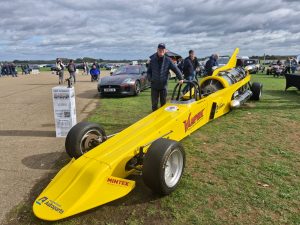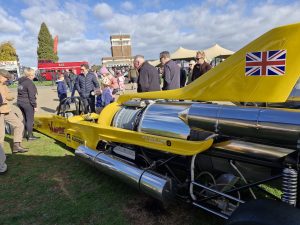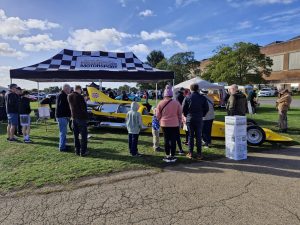The Vampire Jet Car is the UK Current Land Speed Record holder, having achieved an average speed of 300.3 Mph
Built in the late 1970’s the car was raced and demonstrated throughout Europe in the 1980’s. It was subsequently involved in a well publicised accident in 2006 after which it was sold and repairs were initiated by the Phelps family in Northamptonshire who have long history of association with the ‘Santa Pod’ Drag Strip in the UK. It was then acquired by a syndicate of eight people in November 2019 when it was relocated to the town of Bromyard in Herefordshire where a full rebuild and restoration was completed in July 2021
Aerospace Museum Bristol
For the October half-term (25 October – 2 November 2025), Aerospace Bristol is exhibiting the Vampire alongside Concorde Alpha Foxtrot, bringing together two very different but equally iconic feats of engineering. This is the first time these two record-breaking machines have been shown together. Concorde, of course, is the supersonic passenger jet — and the highlight of the museum.
Admission to the museum includes access to see both — meaning visitors can appreciate the ground-based speed demon (the Vampire) right next to a pioneering supersonic airliner. Displaying these together helps “share… the history behind Vampire and Concorde … to motivate young people to become future engineers.”
The Vampire uses a Bristol Siddeley designed and manufactured engine. Showing the restored Vampire (a once-crashed, now-revived machine) next to Concorde illustrates the importance of perseverance, innovation, and engineering passion.
The Vampire Jet Car — Technical & Historical Background
Engineering & Powertrain
•Powerplant: Bristol Siddeley Orpheus 701 turbojet engine — the same model used in the Folland Gnat jet aircraft (and later in the Red Arrows display jets).
•Thrust: Around 5,000 lbf (22 kN) of thrust, with an afterburner for extra acceleration.
•Fuel: Aviation kerosene (Jet A-1).
•Top speed: Achieved 300.3 mph (483 km/h) — still the official UK land speed record.
•Weight: Roughly 1.5 tons, with a long, low chassis to maintain stability at extreme speed.
•Braking: Twin parachutes plus disc brakes — essential since it has no engine braking at all.
History & Fame
•Built: Late 1970s by Russell “Rusty” Parker and Colin Fallows of the Vampire Race Team.
•Racing Era: Active through the 1980s–90s on British & European runways and drag strips.
•2006 accident: During filming for Top Gear, presenter Richard Hammond suffered a near-fatal crash at Elvington Airfield while piloting the Vampire
•Restoration: The car was later fully rebuilt by the Vampire Owners Group — a volunteer team of engineers and enthusiasts — to working condition.
No longer used for competitive runs it appears at engineering, charity and education events e.g., Goodwood Motor Circuit Saywell International Charity Day, airshows, Bicester Scramble, Broadway Car Show, Bromyard Festival of Speed and now Aerospace Bristol.
Concorde Alpha Foxtrot — The Supersonic Counterpart
•Registration: G-BOAF (“Alpha Foxtrot”).
•Built: 1979 at the Bristol Filton factory — the last Concorde ever built and the last to fly.
•Retired: 2003, after its final flight from Heathrow back to Filton.
•Speed: Mach 2.04 (1,354 mph / 2,180 km/h).
•Engines: Four Rolls-Royce/Snecma Olympus 593 turbojets, each producing 38,050 lbf of thrust.
•Crew: 3 (pilot, co-pilot, flight engineer), up to 100 passengers.
Display at Aerospace Bristol
Housed inside a purpose-built hangar where visitors can walk underneath and inside Concorde Alpha Foxtrot, including the passenger cabin and flight deck. The display traces Concorde’s design, testing, and legacy, with artifacts from Filton’s engineering archives. The museum also explores Bristol’s broader aerospace heritage — from WWI aircraft and the Bristol Brabazon, to modern Airbus wings and Rolls-Royce engines.
The Vampire is currently displayed adjacent to Concorde, forming a special “Speed and Innovation” zone for autumn 2025.
Historical Significance
Both machines contain major Bristol-engineered components — the Vampire’s Orpheus jet engine and Concorde’s Filton-built structures.
Aerospace Bristol and VampireJetCar.com are using the display to promote STEM careers — with interactive talks about aerodynamics, jet propulsion, and restoration engineering. Concorde represents civil supersonic achievement; Vampire represents pure experimental speed — two sides of British ingenuity.

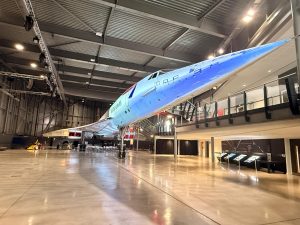

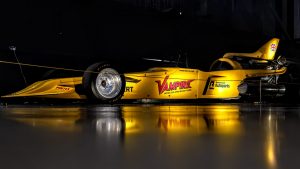
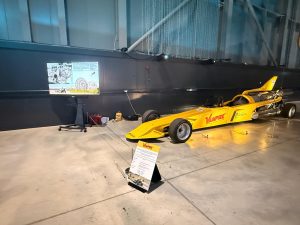
Vampire Jet Car at Bicester Scramble with Mission Motorsport
The Bicester Scramble is a high-profile automotive gathering held at Bicester Heritage, a former RAF base turned motoring enclave. It’s a very “hands-on, community-friendly” show, featuring classic cars, supercars, specialist workshops, and curated displays.
On Sunday, 5 October the Vampire Jet Car was exhibited at the October 2025 Scramble, alongside Mission Motorsport. It was great to see the public’s reaction … and speak with so many knowledgeable enthusiasts. Mission Motorsport is a UK-based charity that helps current and former service personnel through motorsport.
The Vampire jet car is a truly dramatic machine — a jet-powered dragster that holds the UK land speed record. The car’s bright yellow livery, long “dragster” body and visible jet engine made it a very eye-catching feature!
Pairing it with Mission Motorsport links raw engineering performance with a charitable and community-oriented community. It’s not just about speed, but about resilience, service, and giving back.
The Vampire is a jet-propelled dragster and UK land speed record holder, having reached an average speed of 300.3 mph. It was built in the late 1970s, raced in the 1980s, and has a very dramatic history — including a high-profile crash in 2006 involving Richard Hammond. The car uses a Bristol-Siddeley Orpheus turbojet engine paired with an afterburner — powerful enough that it produces huge thrust. After being restored by a dedicated group (the Vampire Owners Group), it’s now used in public displays to both entertain and inspire future engineers.
Clevedon Cars & Coffee
We had a wonderful weekend at The Helicopter Museum (Weston-super-Mare) as guest of the Clevedon Cars & Coffee Group. A fabulous turnout of wonderful vehicles and enthusiastic owners

